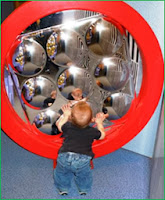 Mirrors
and math concepts are brought together in a unique way in DuPage Children's
Museum’s Math Connections Neighborhood.
Our Crawl Through Kaleidoscope and Cornering Reflections exhibits engage
children in math learning in a playful and creative way!
Mirrors
and math concepts are brought together in a unique way in DuPage Children's
Museum’s Math Connections Neighborhood.
Our Crawl Through Kaleidoscope and Cornering Reflections exhibits engage
children in math learning in a playful and creative way!
Crawl Through Kaleidoscope
In
our Crawl Through Kaleidoscope,
geometry is explored through multiplying patterns and symmetry. As children
moves through the prism tunnel, they see multiple images of themselves. Often,
children stop right in the middle with a look of fascination. This is a
wonderful opportunity to engage the child in ‘math talk.’ How many of you do you see? What happens if you move your arm up? Down?
What colors and shapes do you notice?
To
extend the learning (and create a lasting memory), you might talk about this
experience when peering through a smaller kaleidoscope at home.
Cornering Reflections
Here
we observe children and their caregivers creating patterns with two-dimensional
and three-dimensional geometric shapes. Visitors often stack the shapes and
interact with the multiple reflections they create by moving the mirrors back
and forth. Creating these patterns is an
early introduction to algebra concepts! Children even explore geometry with the
shapes used to create those patterns! Symmetry concepts are investigated as the
mirrors are moved back and forth.











